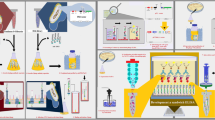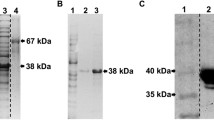Abstract
Clostridium perfringens type D produces enterotoxemia, an enteric disease in ruminants, also known as pulpy kidney disease. Caused by epsilon toxin, enterotoxemia is a major exotoxin produced by this microorganism. Epsilon toxin is also the main component of vaccines against this enteric disorder. In this study, a standardized dot-blot was used to choose strains of C. perfringens type D that are producers of epsilon toxin. Clones producing epsilon toxin were chosen by limiting dilution; after three passages, lethal minimum dose titers were determined by soroneutralization test in mice. These clones produced epsilon toxin 240 times more concentrated than the original strain. The presence of the epsilon toxin gene (etx) was verified by polymerase chain reaction. All clones were positive, including those determined to be negative by dot-blot tests, suggesting that mechanisms in addition to the presence of the etx gene can influence toxin production. The dot-blot test was efficient for the selection of toxigenic colonies of C. perfringens type D and demonstrated that homogeneous populations selected from toxigenic cultures produce higher titers of epsilon toxin.




Similar content being viewed by others
References
Azevedo EO, Lobato FCF, Abreu VLV, Nascimento RAP (1998) Avaliação de vacinas contra Clostridium perfringens tipo C e D [Evaluation of vaccines against Clostridium perfringens type C and D]. Arq Bras Med Vet e Zootec 50:239–242
Bentacor AB, Fermepin MP, Bentacor LD, de Torres RA (1999) Detection of the etx gene (ε-toxin inducer) in plasmids of high molecular weight in Clostridium perfringens type D. FEMS Immunol Med Microbiol 24:373–377
Courtioux B, Bisser S, M′Belesso P, Ngoungou E, Girard M, Nangouma A, Josenado T, Jauberteau-Marchan MO, Boutellie B (2005) Dot enzyme-linked immunosorbent assay for more reliable staging of patients with human African trypanosomiasis. J Clinic Microbiol 43:4789–4795
El Idrissi AH, Ward GE (1992) Development of double sandwich ELISA for Clostridium perfringens beta and epsilon toxins. Vet Microbiol 31:89–99
Fernandez-Miyakawa ME, Sayeed S, Fisher DJ, Poon R, McClane BA, Saputo J, Uzal FA (2007) Development and application of an oral challenge mouse model for studying Clostridium perfringens type D infection. Infect Immun 75:4282–4288
Havard HL, Hunter SE, Titball RW (1992) Comparison of the nucleotide sequence and development of a PCR test for the epsilon toxin gene of Clostridium perfringens type B and type D. FEMS Microbiol Lett 76:77–81
Lobato FCF, Moro E, Umehara O, Assis RA, Martins NE, Gonçalves LCB (2000) Cattle and rabbits immune response against beta and epsilon Clostridium perfringens toxins induced by six commercial vaccines in Brazil. Arq bras Med Vet e Zootec 52:313–318
Lyras D, Rood JI (1997) Transposable genetic elements and antibiotic resistance determinants from Clostridium perfringens and Clostridium difficile. In: Rood JI, McClane BA, Songer JG (eds) The Clostridia: molecular biology and pathogenesis. Academic Press, San Diego, pp 73–92
Nagahama M, Kobayashi K, Ochi S, Sakurai J (1991) Enzyme-linked immunosorbent assay for rapid detection of toxins from Clostridium perfringens. FEMS Microbiol Lett 84:41–44
Parreiras PM, Lobato FCF, Heneine LGD, Assis RA, Balsamão GM, Nascimento RAP (2002) Production and purification of épsilon prototoxin produced by Clostridium perfringens type D. Arq bras Med Vet e Zootec 54:328–330
Sampaio IBM (1998) Estatística aplicada à experimentação animal [Statistics applied to animal testing]. Fundação de Ensino e Pesquisa em Medicina Veterinária e Zootecnia, Belo Horizonte
Sayeed S, Li J, McClane BA (2007) Virulence plasmid diversity in Clostridium perfringens D isolates. Infect Immun 75:2391–2398
Sebald M, Petit JC (1997) Laboratory methods anaerobic bacteria and their identification. Institute Pasteur, Paris
Silva ROS, Salvarani FM, Assis RA, Martins NRS, Pires PS, Lobato FCF (2009) Antimicrobial susceptibility of Clostridium perfringens strains isolated from broiler chickens. Braz J Microbiol 40:261–263
Stott DI (1989) Immunoblotting and dot blotting. J Immunol Methods 119:153–187
Uzal FA, Songer G (2008) Diagnosis of Clostridium perfringens intestinal infections in sheeps and goats. J Vet Diagn Invest 20:253–265
Uzal FA, Plumb JJ, Blackall LL, O’Boyele D, Kelly WR (1996) Detection by polymerase chain reaction of Clostridium perfringens producing epsilon toxin in faeces and in gastrointestinal contents of goats. Lett Appl Microbiol 23:13–17
Uzal FA, Plumb JJ, Blackall LL, O’Boyele D, Kelly WR (1997a) PCR detection of Clostridium perfringens producing different toxins in faeces of goats. Lett Appl Microbiol 25:339–344
Uzal FA, Nielsen K, Kelly WR (1997b) Detection of Clostridium perfringens type D epsilon antitoxin in serum of goats by competitive and indirect ELISA. Vet Microbiol 51:223–231
Weddell W, Worthington RW (1984) An enzyme labelled immunosorbent assay for measuring Clostridium perfringens epsilon toxin in gut contents. NZ Vet J 33:36–37
Acknowledgments
This work was supported by funds from Fapemig, CNPq, and FEPMVZ.
Author information
Authors and Affiliations
Corresponding author
Additional information
Communicated by Erko Stackebrandt.
Rights and permissions
About this article
Cite this article
Gonçalves, L.A., Lobato, Z.I.P., Silva, R.O.S. et al. Selection of a Clostridium perfringens type D epsilon toxin producer via dot-blot test. Arch Microbiol 191, 847–851 (2009). https://doi.org/10.1007/s00203-009-0510-y
Received:
Revised:
Accepted:
Published:
Issue Date:
DOI: https://doi.org/10.1007/s00203-009-0510-y




